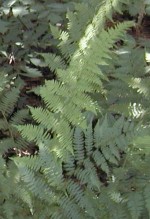 I am partial to ferns so I am likely to incorporate almost any fern into my garden but this fern offers some unique characteristics that make it special. It forms large colonies of fronds in a helter-skelter pattern. If you don’t like a casual look this is not the fern for you. But, on the other hand, if you are drawn to a plant that “does its own thing” you might find this fern especially appealing. It has a creeping rootstock with black wiry roots that send up yellow-green fronds in interesting patterns and it will add a fine texture to the garden while rapidly filling the space. A native of damp woods in eastern United States, it is a deciduous fern and turns brown in early fall.
I am partial to ferns so I am likely to incorporate almost any fern into my garden but this fern offers some unique characteristics that make it special. It forms large colonies of fronds in a helter-skelter pattern. If you don’t like a casual look this is not the fern for you. But, on the other hand, if you are drawn to a plant that “does its own thing” you might find this fern especially appealing. It has a creeping rootstock with black wiry roots that send up yellow-green fronds in interesting patterns and it will add a fine texture to the garden while rapidly filling the space. A native of damp woods in eastern United States, it is a deciduous fern and turns brown in early fall.
Type: Deciduous fern
Bloom: Not applicable
Foliage: Fine textured fronds are 4″ wide and 1-5″ wide, tapering at both ends.
Size: 1-2’ H x 1-2’ W
Light: Part shade to shade
Soil: Humus-rich, moist to average, slightly acidic (pH 6.8); survives in dry conditions
Hardiness: Zones 5-8 (less aggressive in southern part of the range)
Care: Reduce spread to desired level; add compost annually
Pests and Diseases: None of significance
Propagation: Division of rhizomes in early spring or fall; spores
Companion plants: Good cover for areas left by spring ephemerals such as Trilliums, bloodroot (Sanguinaria Canadensis), Dutchmans’s breeches (Dicentra cucullaria) and spring beauty (Claytonia virginica); foamflower (Tiarella cordifolia), fringed bleeding heart (Dicentra eximia), and phlox (Phlox divaricate).
